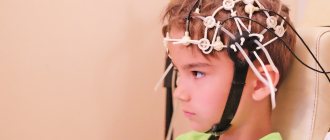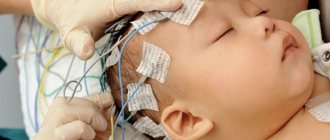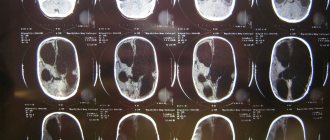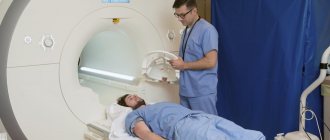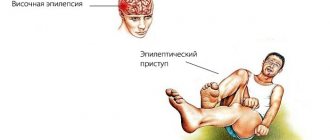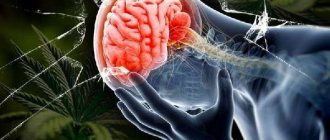Epilepsy is a disease that has been known to mankind for a long time. Even in ancient times, it had many names and was perceived ambiguously, since it was attributed to demonic origin and was very feared.
Today, in 40% of cases, scientists also fail to establish the true cause of this pathology, but it is known that epilepsy is a chronic neurological disease and its development is facilitated by a number of factors that have absolutely nothing to do with anything supernatural.
Concept
When faced with this disease, a person asks many questions, namely, how dangerous epilepsy is, what it can lead to, and whether it is possible to die from it. To answer them, it is necessary to take into account many factors, such as: the type of epilepsy, the stage of the disease, the age of the patient and the presence of concomitant pathologies in the body.
Causes and symptoms of epileptic seizures
Convulsions occur in response to various negative factors. A single case of seizures is not a reason to diagnose a disease such as epilepsy. You can suspect it only if the seizures recur. They are also characterized by spontaneity, that is, they appear unexpectedly, for no apparent reason.
To answer the question of why epilepsy is dangerous and what its consequences are, it is necessary to understand what exactly triggered the development of the epileptic focus. The most common reasons include:
- heredity;
- traumatic brain injuries, concussions;
- cerebrovascular accidents (epilepsy can occur due to stroke);
- drug and alcohol addiction;
- pathological development of the fetus (if a woman has an epileptic attack during pregnancy, this can lead to serious consequences for the child, including the development of the same disease);
- parasitic diseases and brain tumors.
Factors that negatively affect the functioning of the brain lead to the appearance of an area that at any moment can give rise to an epileptic seizure. The cause could be anything from bright flashes of light, open flames, certain food additives and ingredients, certain medications, and more. At the time of an attack, a person is not able to control his actions, so the risk of injury is very high. As a rule, the first epileptic seizure occurs at an early age (before 18 years). In adults, epilepsy develops less frequently, but this makes its consequences no less dangerous. Unfortunately, at the moment there is no exact answer to the question of whether the disease is congenital or acquired.
Depending on the reasons for the development of the pathological focus, the most common types of disease are distinguished:
- Focal epileptic form. It is a hereditary disease that develops subsequently from congenital disorders.
- Symptomatic epilepsy. Hereditary predisposition also plays a role in the development of the disease, but most often it is provoked by external factors. In their absence, a person will never experience an epileptic seizure and will not face its consequences.
- Epileptiform syndrome. The occurrence of a convulsive epileptic attack as a result of a sharp external influence.
- Temporal lobe epilepsy. The most common form of the disease, characterized by the localization of the pathological focus in the temporal region of the brain.
Often, doctors cannot accurately determine which of the above conditions is observed in a patient. Therefore, during the examination, the mechanisms of epilepsy development are discussed in order to determine what consequences they may have on the brain.
Different types of epilepsy manifest themselves in their own way, and therefore the consequences of the disease are very diverse. However, for all forms there is a common number of characteristic symptoms. The number of damaged brain cells plays a key role in the intensity and duration of epileptic seizures. Symptoms of seizures range from mild convulsions to brief fainting. In addition, the nature of seizures can change over the course of the disease, and if left untreated, epilepsy will have serious consequences.
There are several constant characteristic features of epileptic seizures:
- Sudden onset. If a person suffers from epilepsy, it is impossible to accurately predict when the next seizure will occur. This feature is the main factor that has negative consequences for the psyche. A patient with epilepsy constantly arrives in anticipation of an attack and experiences nervous tension. At the same time, many people with this disease experience a so-called aura - a short-term condition accompanied by discomfort in the abdomen, the sensation of various odors, spots before the eyes, a feeling of anxiety, buzzing in the ears, etc. In this way, patients can recognize the onset of an epileptic attack and take measures aimed at eliminating its consequences.
- Non-duration. In epilepsy, a seizure lasts from a fraction of a second to several minutes. Depending on the form of the disease, the patient may behave differently: one freezes and does not even notice the seizure, while another may lose consciousness. There may also be several attacks. They come one after another, and this is the most dangerous condition for the patient.
- Abrupt cessation. Epilepsy attacks end as suddenly and unexpectedly as they begin. Often, stopping a seizure does not even require the use of medications. They are necessary only in the case of a series of attacks or in situations where the cause was a specific factor. Medicines should also be used for childhood epileptic seizures accompanied by high fever.
- Repetition of the same seizures. If an attack of one type occurs, its manifestation in the future will be the same. But if epilepsy is left untreated, the consequences of the disease will be more severe and severe seizures.
A disease such as epilepsy invariably leaves its mark on the lives of people suffering from it. It is impossible to get used to seizures, and after each attack a person feels broken and empty.
Expert opinion
Author: Olga Vladimirovna Boyko
Neurologist, Doctor of Medical Sciences
For many years, epilepsy has been considered a dangerous neurological disease. The prevalence of the disease is 4-8 people per 1000 population. According to statistics, 80% of patients with epilepsy live in countries with low or medium levels of development. The danger of seizures lies in their consequences. Attacks occur unexpectedly, which leads to falls and injuries. 30% of patients become disabled in groups 1 or 2.
To date, doctors have not been able to determine the exact causes of epileptic seizures. At the Yusupov Hospital, diagnostics are carried out using European medical equipment: CT, MRI, EEG. Modern drugs are used to treat epilepsy and its consequences. They are included in the list of the latest world standards for the treatment of epileptic seizures. An individual therapeutic plan is developed for each patient - experienced neurologists and epileptologists take into account the characteristics of the development of the disease, the patient’s age and concomitant conditions. Specialists at the Yusupov Hospital provide preventive recommendations that reduce the risk of recurrent attacks. If medical prescriptions are followed, most patients go into long-term remission.
What's the forecast?
If epilepsy is properly treated, then in eighty percent of cases, people with this disease live without any seizures and without restrictions in activity.
Many people have to take antiepileptic drugs throughout their lives to prevent seizures. In rare cases, a doctor may stop taking medications if a person has not had a seizure for several years. Epilepsy is dangerous because conditions such as suffocation (which can occur if a person falls face down on a pillow, etc.
As for generalized tonic-clonic seizures, they can be fatal. People who experience these attacks need constant monitoring, at least from relatives.
Consequences and complications of epilepsy
If left untreated, epilepsy constantly progresses. First of all, this is expressed in the frequency of seizures. And if in the initial stages they occurred once every few months, then in the absence of treatment a person can experience them several times a week. The consequence of every seizure is the destruction of nerve fibers, which can ultimately lead to swelling of the brain.
In order to more accurately answer the question of why epilepsy attacks are dangerous, it is necessary to proceed from:
- type of disease;
- patient's age;
- degree of brain damage;
- the presence of symptoms characteristic of epilepsy;
- duration of an epileptic attack;
- timeliness of treatment;
- quality of prescribed therapy.
Epilepsy in children interferes with their normal physical and mental development. The consequences of epilepsy in adults are quite extensive.
Injuries after epilepsy attacks
During a seizure, the patient loses control over his body. In this condition, the risk of serious injury is greatly increased. If a person loses consciousness, then when falling, the following may occur:
- traumatic brain injury;
- limb fracture;
- bruises of varying severity.
An epileptic seizure occurs regardless of where a person is and what he is doing. It can take you by surprise at work, on vacation, in transport, etc.
Accidents
Sudden seizures can cause traffic accidents. A patient with epilepsy should refrain from swimming in water, as during convulsive attacks he may drown. There is an increased risk of work-related injury, so people with epilepsy need to create a safe working environment. A severe seizure can also result from a fall from a great height.
Intellectual impairment
30% of patients with epilepsy experience deterioration in intellectual abilities. Memory also decreases due to the disease. A patient with epilepsy should, in principle, avoid activities that require increased attention and focus, as this may provoke a seizure. Intellectual impairment due to epilepsy is more common in children. In adults, decreased mental abilities are a consequence of temporal lobe epilepsy.
Behavioral distortions
Epilepsy affects people's behavior. The patient's personality may change beyond recognition. His mood becomes changeable. A constant feeling of anxiety eventually turns into anger. A person feels the need to defend himself, so he becomes aggressive. Other patients with epilepsy, on the contrary, begin to behave emphatically politely and show increased concern for both themselves and others. Behavioral distortions in this disease are purely individual and are not necessarily present in every patient.
Mental changes
Epileptic seizures have a devastating effect on the functioning of the brain, so patients often experience mental changes. If epilepsy is not treated, they will constantly increase. The hardest thing is for patients with pronounced, severe attacks that do not go unnoticed for them. Such patients are depressed and depressed. Mental changes are triggered by the death of neurons, so it is very difficult to fight the feeling of emptiness and despair.
Psychological problems
People diagnosed with epilepsy experience difficulties with social adaptation. They face misunderstanding from others, which is associated with misconceptions about this chronic illness. Many patients tend to self-isolate because they feel like a burden to loved ones. To improve the condition of a patient with epilepsy and alleviate the consequences for his psyche, it is necessary to combine drug treatment with psychotherapy.
Status epilepticus
A condition in which convulsive seizures follow one after another and in their intervals the patient does not regain consciousness is called status epilepticus. It is a complication of epilepsy that was not treated in time. In addition to blackouts, status epilepticus is also characterized by incompletely generalized convulsive seizures. The condition is life-threatening, since respiratory arrest often occurs during attacks, and is often the main cause of death in patients with epilepsy.
Status epilepticus has three phases:
- Tonic. Lasts for 30 seconds. During this phase, the patient loses consciousness, his face turns pale, breathing slows down and stops. The patient's limbs are tense and extended, the chest freezes while inhaling.
- Convulsive. Within 10-12 minutes, the patient's arms, legs and tongue tremble. He may bite his tongue and cheek. Often foam comes out of the mouth. In this condition, involuntary urination or defecation is also possible.
- Comatose phase. The patient does not regain consciousness, his pupils are dilated and his muscles are relaxed. The condition has features similar to deep sleep. It can last for hours or even days.
Coma after an epileptic attack
People with status epilepticus often fall into a coma from which they may not recover for a long time. This is due to incorrect first aid. When the patient is in a comatose phase, he should not be awakened. All measures should be aimed at eliminating cerebral edema, which develops due to the destruction of neurons.
Who is at risk?
People with low socioeconomic status and comorbid mental illness die at higher rates than those without these problems.
Unexpected seizures in patients who are using previously well-working antiepileptic therapy usually occur due to non-compliance with it or a change in the list of drugs. A single missed dose can already worsen the condition, but these are exceptional cases, in contrast to systematic non-compliance with the pill regimen. The best drugs won't help if you don't take them, and lack of treatment can increase the risk of death.
The mental illness associated with epilepsy can lead to death due to accident or suicide. Epilepsy is often complicated by depression, impulsivity, psychosis, and substance abuse. Treating these complications reduces the risk of death and disability.
In most studies, doctors identify additional factors for the increased risk of death in epilepsy:
- disease experience more than 15 years;
- epilepsy began before the age of 16 years;
- young age;
- male gender.
Can we reduce the risk?
Most cases of sudden death from epilepsy occur during sleep, when the patient's condition is uncontrolled and the likelihood of death increases. Solution: use of a shared room or nightly audiovisual monitoring. Once a patient is aware of a seizure, another person can turn the patient onto their side (safe position), give medication, stimulate breathing (pills), or wake them up, thereby significantly reducing the risk of death.
Just as lifestyle changes and treatment of hypertension can prevent stroke, controlling epilepsy with drugs, diet and, if necessary, surgery, while limiting hazardous activities, will prevent many seizures, disease progression and death.
Monitor changes in your condition, response to events and therapy. Timely correction of lifestyle and treatment regimen, as well as the presence of a person who will provide first aid in the event of an attack, can save lives.
Epilepsy is a neurological disease that is potentially fatal. The seizure itself can be fatal. The risk of death increases from complications of seizures: falls, road accidents. Specific treatment helps protect against an unfavorable outcome.
Consequences of epilepsy during pregnancy
Epilepsy poses a significant barrier to women wishing to become pregnant and have children. Carrying a fetus in itself is a difficult test for the body. During pregnancy, changes in the functioning of all organs of the body are observed, and changes also occur at the hormonal and biochemical level. If a woman has epilepsy, this significantly affects the course of the disease. First of all, the frequency, duration and nature of seizures change. In some patients they may become more frequent, while in others they may appear less frequently.
Changes in the incidence of epileptic seizures are also a consequence of changing medications or completely abandoning drug treatment. Fearing for the health of their unborn baby, pregnant women change anticonvulsant medications, as well as the dose and regimen of taking them, which has a detrimental effect on their own condition.
Uncontrolled seizures during pregnancy increase the risk of injury from a fall. Increased stress on the cardiovascular system can cause sudden death.
A dangerous consequence of attacks for a child is oxygen starvation, which can disrupt normal development.
Epilepsy is characterized by hereditary nature. That is, the likelihood that in the future the child may also suffer from this disease is quite high. Therefore, it is necessary to plan a pregnancy under the strict supervision of the attending physician. Proper management and preparation of expectant mothers with epilepsy increases the chances of having completely healthy children.
Death during an attack
Do people die from epileptic seizures? The honest answer is yes. However, this does not mean that every patient will end his life during a seizure.
In order for a life to end in this way, a certain combination of circumstances is necessary:
- potentially fatal injury due to a fall or convulsions in generalized epilepsy;
- Prolonged oxygen starvation. During an attack, a spasm of the respiratory muscles deprives the patient of the opportunity to breathe. Usually breathing is interrupted for 5-20 seconds, which does not have time to cause severe harm. However, with epistatus, a prolonged cessation of breathing is possible, due to which irreparable damage is caused to the brain.
- When intoxicated, the chance of not coming out of an attack alive increases significantly. Because the brain experiences both overstimulation and intoxication at the same time.
- Vomiting, large amounts of saliva and foam are also deadly. After all, if the head is in the wrong position, the patient will simply choke.
Also, in some cases, attacks of the disease may occur that develop in the body independently of epilepsy.
Forecast and prevention measures for epilepsy
Modern medicine knows more than 40 different forms of epilepsy. Each of them has its own consequences. Knowing the exact cause of the disease and having a clear idea of its course, it is possible to make a prognosis for its further development. In 70-80% of cases, epilepsy responds well to treatment. Some types of illness go away on their own without treatment. As a rule, this applies to epilepsy that manifests itself in childhood. The attacks stop during adolescence, and the mental and physical development of people returns to normal.
The timely correct identification of the specific form of epilepsy is of fundamental importance. The treatment strategy and prognosis of the course of the disease depend on this.
The danger of this disease lies not so much in epileptic seizures, but in their consequences - injuries suffered due to them and acquired pathologies. The right decision in the treatment of epilepsy would be to use preventive measures to reduce the frequency of seizures.
There are no specific methods for preventing this disease, but general recommendations include:
- a healthy lifestyle, which includes giving up alcohol, smoking and drugs;
- moderate physical activity;
- proper nutrition and rest;
- elimination of emotional shocks and stress;
- timely treatment of infectious diseases;
- prompt reduction of high temperature;
- constant monitoring of blood pressure;
- avoiding overheating or hypothermia of the body.
With the right therapeutic approach, compliance with the dose and regimen of anticonvulsants, the consequences of epilepsy can be significantly minimized.
Author
Boris Yuryevich Bobrov
Endovascular surgeon, Candidate of Medical Sciences. Laureate of the Russian Government Prize in the field of science and technology, laureate of the Vocation Award.
The influence of pathology on the patient’s life
Previously, benign types of epilepsy included varieties of the course that did not interfere with everyday life. Today, the classification has changed and in this group only those types of pathology that resolve over time without a course of therapy remain. The benign form now affects only children and often epileptic seizures stop no later than 18 years. Medicines are used only to alleviate the general condition and only in rare cases.
The malignant course of epilepsy is represented by all other forms. It is completely impossible to get rid of them, but there is a chance to stop the manifestations of the pathology. To do this, the patient must strictly follow the doctor's instructions. If you manage to stop epileptic seizures, the following prospects will open up:
- Full life;
- Trips;
- The opportunity to engage in mental and physical activity for your own pleasure.
In Europe, epileptics are allowed to drive if they have not had seizures in the coming years. However, you will have to be examined annually and registered with a doctor. In Russia, people suffering from epilepsy often continue to drive and hide their illness, which often leads to accidents on the road.
Bibliography
- ICD-10 (International Classification of Diseases)
- Yusupov Hospital
- Bryukhanova N.O., Zhilina S.S., Ayvazyan S.O., Ananyeva T.V., Belenikin M.S., Kozhanova T.V., Meshcheryakova T.I., Zinchenko R.A., Mutovin G. R., Zavadenko N.N.. Aicardi-Goutieres syndrome in children with idiopathic epilepsy // Russian Bulletin of Perinatology and Pediatrics. — 2020. — No. 2. — P. 68–75.
- Victor M., Ropper A.H. Guide to neurology according to Adams and Victor: textbook. manual for the postgraduate system. prof. physician education / Maurice Victor, Allan H. Ropper; scientific ed. V. A. Parfenov; lane from English edited by N. N. Yakhno. — 7th ed. — M.: Med. information agency, 2006. - 677 p.
- Rosenbakh P. Ya.,. Epilepsy // Encyclopedic Dictionary of Brockhaus and Efron: in 86 volumes (82 volumes and 4 additional). - St. Petersburg, 1890-1907.
Side effects
The following side effects may occur with a keto diet:
- The stool is broken.
- Activity decreases.
- The acidity of the blood changes (decreases).
- In case of diabetes, this diet is fraught with death.
If the ketone diet is contraindicated for you, you just need to pay attention to what you eat. It makes sense to refuse:
- food that is difficult to digest;
- salty;
- acute;
- smoked
Liquid intake is limited.
Ketogenic nutrition, due to the high fat content of consumed foods and lack of vitamins, sometimes has side effects:
- Fatigue, drowsiness, nausea, dizziness (at first).
- Hair loss.
- Change in weight (depends on the level of mobility of the patient, the characteristics of his metabolism).
- Increased cholesterol levels.
- Intestinal bloating, flatulence, constipation, gastrointestinal dysfunction.
Some side effects are reversible, others require dietary adjustments or complete abolition. All these decisions are made by treating specialists - a nutritionist and a neurologist.
Thus, the ketogenic diet is used as an alternative method of treating epilepsy (to weaken and reduce seizures). This diet is prescribed by a nutritionist together with a neurologist or epileptologist.
Despite some contraindications and a number of side effects, ketogenic nutrition often brings positive results - using it for several years, you can achieve a stable improvement in the patient’s condition.
First aid
The main thing is to remain calm. How to identify epilepsy? If a person has convulsions and the pupils are dilated, then this is an epileptic seizure.
First aid for an epileptic seizure includes ensuring safety: the epileptic’s head is placed on a soft surface, sharp and cutting objects are removed.
Do not restrain convulsive movements. It is forbidden to put any objects into the patient’s mouth or unclench his teeth.
When vomiting occurs, the person is turned over on his side so that the vomit does not end up in the respiratory tract.
The duration of convulsions is a couple of minutes. If the duration lasts more than 5 minutes or there are injuries, call an ambulance. Afterwards the patient is placed on his side.
Minor attacks do not require outside intervention.
But if the seizure lasts more than 20 minutes, then there is a high probability of status epilepticus, which can only be stopped by intravenous medications. First aid for this type of epilepsy is to call a doctor.
Symptoms
The peculiarity of the disease is that the patient cannot fully understand what is happening. People around you are not always able to provide proper assistance when an attack occurs.
The main symptoms of epilepsy in adults and children are periodic seizures, during which the following are noted:
- convulsive movements;
- lack of response to external influences;
- loss of consciousness;
- jerky convulsions of the whole body;
- the head is thrown back;
- profuse salivation.
Sometimes it can happen that with epilepsy, intellectual capabilities suffer and ability to work decreases. In some patients, on the contrary, sociability, attention and hard work increase.
In epileptics, thought processes are slowed down, which affects behavior and speech. Even clear speech is laconic, but rich in diminutive phrases. People begin to detail and explain the obvious. They find it difficult to change topics of conversation.
Effective therapy
Treatment measures to eliminate all manifestations of epilepsy can be carried out in neurological or psychiatric hospitals. When epilepsy attacks lead to uncontrollable behavior in a person, as a result of which he becomes completely insane, treatment is carried out compulsorily.
As a rule, this disease is treated with the help of special medications. If partial seizures occur in adults, they are prescribed Carbamazepine and Phenytoin. For tonic-clonic seizures, it is advisable to use the following medications:
- Valproic acid;
- Phenytoin;
- Carbamazepine;
- Phenobarbital.
Drugs such as ethosuximide and valproic acid are prescribed to patients for the treatment of absence seizures. People suffering from myoclonic seizures are treated with Clonazepam and Valproic acid.
To relieve the pathological condition in children, drugs such as ethosuximide and acetazolamide are used. But they are actively used in the treatment of adults suffering from absence seizures since childhood.
When using the medications described, you must adhere to the following recommendations:
- For those patients taking anticonvulsants, blood tests should be done regularly.
- Treatment with valproic acid is accompanied by monitoring the state of liver function.
- Patients must comply with established driving restrictions at all times.
- Anticonvulsant medications should not be abruptly interrupted. Their abolition is carried out gradually, over several weeks.
If drug therapy does not have the desired effect, then they resort to non-drug treatment, which includes electrical stimulation of the vagus nerve, traditional medicine and surgery.
Surgery involves removing the part of the brain where the epileptogenic focus is concentrated. The main indicators for such therapy are frequent seizures that are not amenable to drug treatment.
In addition, it is advisable to perform surgery only when there is a high percentage of guarantee of improvement in the patient’s condition. The possible harm from surgical treatment will not be as significant as the harm from epilepsoid seizures. A prerequisite for surgical intervention is an accurate determination of the localization of the lesion.
This type of therapy is very popular in cases where drug treatment is ineffective and surgical intervention is unjustified. This manipulation is based on moderate stimulation of the vagus nerve using electrical impulses. This is ensured by the action of an electrical pulse generator, which is sutured under the skin in the upper part of the chest on the left. The wear life of this device is 3–5 years.
Stimulation of the vagus nerve is allowed for patients over 16 years of age who have focal epileptic seizures that are not amenable to drug therapy. According to statistics, in approximately 1 40–50% of people, when performing such manipulation, their general condition improves and the frequency of seizures decreases.
It is advisable to use traditional medicine only in combination with the main therapy. Today, such medicines are available in a wide range. Infusions and decoctions based on medicinal herbs will help eliminate cramps. The most effective are:
- Take 2 large spoons of finely chopped motherwort herb and add ½ liter of boiling water. Wait 2 hours for the drink to set, strain and consume 30 ml 4 times a day before meals.
- Place a large boat of blackroot roots in a container and add 1.5 cups of boiling water to it. Place the pan over low heat and simmer for 10 minutes. Take the prepared decoction half an hour before meals, a tablespoon 3 times a day.
- Excellent results are achieved when using wormwood. To prepare the drink, you need to take 0.5 tablespoon of wormwood and pour 250 ml of boiling water. Take the prepared decoction 1/3 cup 3 times a day before meals.
Epilepsy is a very serious disease that requires immediate and ongoing treatment. Such a pathological process can arise for a variety of reasons and affect both an adult and a child’s body.
Alcoholic epilepsy is a common complication that leads to chronic alcoholism. Seizures with or without convulsions are a reaction of the nervous system to alcohol poisoning. At first they appear after drinking alcohol, but as the course of the disease becomes chronic, they continue in a sober state.
Treatment
Almost all types of epileptic seizures can be controlled with medications. In addition to medications, diet therapy is prescribed. If there is no result, they resort to surgical intervention.
Treatment of epilepsy in adults is determined by the severity and frequency of seizures, age and health status. Correct determination of its type increases the effectiveness of treatment.
Medications should be taken after examinations. They do not treat the cause of the disease, but only prevent new attacks and progression of the disease.
The following groups of drugs are used:
- anticonvulsants;
- psychotropic;
- nootropic;
- tranquilizers;
- vitamins.
High efficiency is observed in complex treatment when maintaining a work/rest balance, eliminating alcohol, and proper nutrition.
Epileptic seizures can be provoked by loud music, lack of sleep, physical or emotional stress.
You need to be prepared for long-term treatment and regular medication use. If the frequency of attacks decreases, the amount of drug therapy can be reduced.
Surgical intervention is prescribed for symptomatic epilepsy, when the cause of the disease is aneurysms, tumors, and abscesses.
Surgeries are performed under local anesthesia to monitor the integrity and response of the brain. The temporal form of the disease responds well to this type of treatment – 90% of patients feel better.
In the idiopathic form, callosotomy may be prescribed - cutting the corpus callosum to connect the two hemispheres. Such an intervention prevents recurrence of attacks in 80% of patients.
Diagnostics
Diagnosis begins with a detailed interview with the patient and those around him, who will tell you what happened. The doctor must know the patient's general health and the characteristics of the attacks and how often they occur.
It is important to find out whether there is a genetic predisposition.
After collecting anamnesis, they proceed to a neurological examination to identify signs of brain damage.
An MRI is always done to rule out diseases of the nervous system, which can also provoke seizures.
Electroencephalography allows you to study the electrical activity of the brain. The interpretation should be done by an experienced neurologist, since epileptic activity occurs in 15% of healthy people.
Often, between attacks, the EEG picture is normal, then the attending physician provokes pathological impulses before the examination.
During diagnosis, it is important to determine the type of seizures in order to correctly prescribe medications. For example, myoclonic epilepsy can only be differentiated in a hospital setting.

